How The Right Steps In The 2019 Budget Make Your Tomorrow Better

“Giving money and power to government is like giving whiskey and car keys to teenage boys.”
—P.J. O’Rourke
Ventura faces severe revenue shortfalls in six of the next seven years, the size of those during The Great Recession. Ventura is on pace to lose over $9.07 million over the next six years. You should be concerned about the financial conditions in the City of Ventura, and you should also know this budgetary crisis is avoidable if the City Council acts this year.
Ventura’s General Fund Financial Outlook For The Next 10 Years
Ventura city staff calculate the city’s revenue and expenses for the next ten years [see graphic]. Costs will exceed income for six consecutive years beginning in the fiscal year 2020-2021—that’s next year.
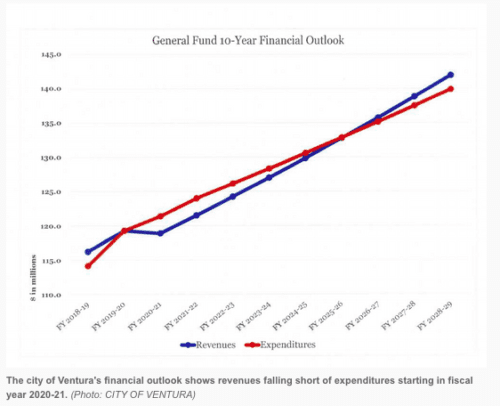
Pensions are the main reason for the rise in expenditures. Annual pension costs will climb to $31.48 million from $19.71 million by the fiscal year 2025-2026. That’s an $11.63 million increase. The city projects property and sales taxes to increase by only $10.6 million over the same period. Not a rosy outlook.
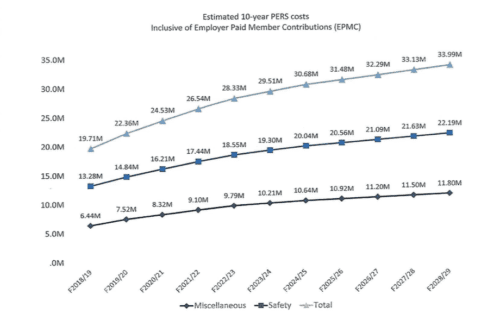
Next year (the fiscal year 2020-2021), Ventura faces a $2.52 million deficit because of the $2.17 million in rising pension costs.
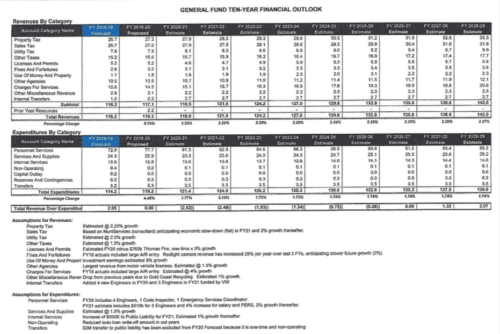
The city staff estimations are optimistic. They do not factor in a recession, which some believe is imminent. If a recession comes, people will lose jobs. Also, if a recession hits, property and sales tax revenues will suffer and projected losses may be even worse. What’s more, the city plans to add no money to reserves in the fiscal year 2019-2020. Current reserve levels for the City of Ventura will keep the city government running for only 45 days.
Wasn’t Measure O supposed To Save The Budget?
Measure O passed three years ago and will continue for the next 22 years. It brings in $10.8 million in additional sales tax revenue each year. Still, it isn’t enough to cover the projected shortfalls. Why is that?
There are several reasons why Measure O can’t save the city’s budget. First, there is no consensus among the City Councilmembers about how to use Measure O money. Alex McIntyre, Ventura’s new City Manager, asked all seven Councilmembers individually how they would spend it. All seven Councilmembers gave differing opinions on how to use the Measure O taxes. Without clear direction, it’s difficult for the City Manager to focus the city staff on what’s most important for our city. Confusion over Measure O is one example of how the City Council is dysfunctional on the budget’s priorities.
 A second problem is how special interest groups lined up to get their share of Measure O. At the May 20th City Council meeting, Councilmembers Lorrie Brown, Jim Friedman and Mayor Matt LaVere tried to move funds from Measure O to the General Fund for Fire Station No. 4. The Star report said the Fire Department union members felt insecure (sic) about Station No. 4 funding coming out of a temporary tax fund. (The tax lasts for 25 years)
A second problem is how special interest groups lined up to get their share of Measure O. At the May 20th City Council meeting, Councilmembers Lorrie Brown, Jim Friedman and Mayor Matt LaVere tried to move funds from Measure O to the General Fund for Fire Station No. 4. The Star report said the Fire Department union members felt insecure (sic) about Station No. 4 funding coming out of a temporary tax fund. (The tax lasts for 25 years)
In 2016, The City Council sold Measure O to voters with the promise that Fire Station No. 4 would remain open with its funds. Voters agreed to the idea of a temporary 25-year tax. VFD is now trying to persuade the City Council that when Measure O expires, there may not be funding for Fire Station No. 4. They fearmonger that response times to calls will increase, and lives could be lost. A 4-3 vote defeated the motion.
While this City Council takes precious time debating moving funds from one column to another, the growing unfunded pension obligations put pressure on the entire city budget, even with Measure O.
The Canaries In The Coal Mine
 Economic disasters are all around us. There is no reason to think that Ventura is immune to them. The City of Oxnard is preparing to lay off hundreds of employees. They also plan to close a fire station and reduce the number of fire personnel available to respond to emergencies. The Oxnard City Manager says, “We are down to bare bones.” What’s happening in Oxnard is a preview of what could happen in Ventura unless the City Council acts quickly.
Economic disasters are all around us. There is no reason to think that Ventura is immune to them. The City of Oxnard is preparing to lay off hundreds of employees. They also plan to close a fire station and reduce the number of fire personnel available to respond to emergencies. The Oxnard City Manager says, “We are down to bare bones.” What’s happening in Oxnard is a preview of what could happen in Ventura unless the City Council acts quickly.
Ventura County Medical Center is losing over $40 million per year. That adds more unemployment to our community. With the City of Ventura own forecast of financial shortfalls, the City Council would do well not to ignore the economic disaster warning like ‘a canary in a coal mine.’
How Do We Fix The Budget?
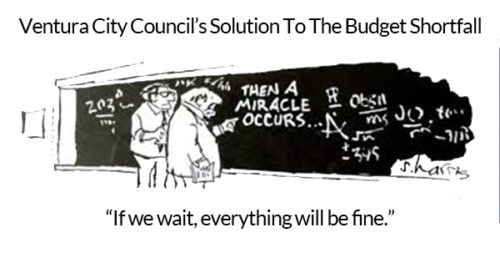 The budgetary crisis is entirely avoidable if the City Council acts now. The solutions are simple, but they are not easy. It requires significant political will and resolve.
The budgetary crisis is entirely avoidable if the City Council acts now. The solutions are simple, but they are not easy. It requires significant political will and resolve.
Improve The Budgeting Process
Currently, the City Council approves the city’s annual budget one year at a time. It doesn’t consider subsequent years’ financial demands. Given that the 10- year forecast shows losses for the next six years’ budgets, to ignore the next six years will be pushing the problem “down the road.”
Now is the time to change this systemic shortsightedness. City Councilmembers have the opportunity to discuss budgeting on at least a 3-year basis, not one year at a time.
Not Filling All Open Positions In City Hall
To balance the budget over the next six years, the city staff has two potential solutions. They can increase revenue through taxes and fees or reduce expenses. Since it’s not easy or popular to raise taxes and fees, the alternative is to cut costs.
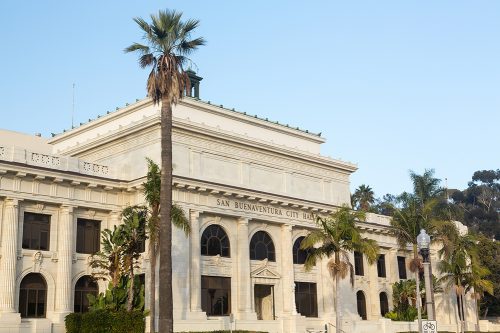
The single largest expense category is city employees. Cutting staff is the obvious choice to reduce expenses. To avoid the unpopular cutting of current employees, the City Council can take a less unpleasant path and cut positions in the budget that the city never filled.
There are currently sixty unfilled positions at City Hall. If each vacant position costs the city $100,000 per person (salary, overtime, retirement and benefits), the cost to budget for these open positions adds to the projected deficit (losses).
If the city reduces the unfilled positions to thirty instead of sixty, the savings to Ventura would be $3 million per year. A $3 million reduction in expenses will balance the budgets for the next six years.
This decision puts the City Council on the horns of a dilemma. Should they hire all sixty positions now and later fire employees during the budget shortfalls? Alternatively, should they hire only thirty people knowing they can add personnel if the city’s economic situation improves? Eliminating unfilled staff positions is less disruptive to city government than laying people off.
Economic Development
An alternative toward improving the budget is to attract new or expanding businesses to Ventura. Several Councilmembers understand this and agree. More business and local jobs are the best solution for filling the budgetary shortfalls. More jobs generate more sales tax, encourage community spending and increase property values. Higher property values increase property taxes and reduce blight.
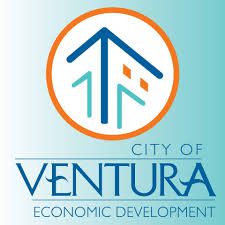 Imagine the stimulus to the community of filling the old Star Free-Press building or the Toys-R-Us location would have.
Imagine the stimulus to the community of filling the old Star Free-Press building or the Toys-R-Us location would have.
The city has already taken the first step in this direction. City Manager, Alex McIntyre, has moved the Economic Development division under the City Manager from under Community Development. Elevating the reporting of this department to the City Manager signals the increased importance economic development has for the city.
Empower The Economic Development Manager
Another simple step the city could take would be to empower the Economic Development Manager (EDM). The EDM must have readily available an inventory of all commercial locations, complete with square footage, zoning, parking, pricing, and a list of commercial real estate agents and contact information.
The City Council must be ready to provide incentives to new or expanding businesses. The incentives must include fee reductions and process simplification to entice the companies. One such motivator must be a single contact within the city who will guide the relocation process through the bureaucracy.
Finally, the EDM must identify and target new commercial business to locate in Ventura.
Each of these positive steps toward economic development has one drawback. They are long-term solutions. None of them will happen quickly enough to fix a budget by next year.
Streamline the City Hall Experience
The city has started reorganizing boards and commissions that oversee Planning, Design Review, Historic Preservation, and other committees filled by residents appointed by the City Council. While this is a good start, it must go further.
Reducing boards and commissions saves staff time in preparing and attending meetings. The staff attends about 20 meetings a month. Fewer meetings will allow more time for the employees to better supervise operations in planning, design review, code enforcement, etc.
The city must look at other ways to reduce staff time in other duties—especially if the city hires only thirty of the sixty unfilled positions. All staff operations should be scrutinized to end obsolete or redundant activities.
Revamp Ventura Fire Department
Now is a good time to modernize the fire department. Ventura Fire operates in much the same way it did 100 years ago except the needs are far different:
- Building codes are stricter making fires less frequent
- More buildings have sprinkler systems
- Over 75% of calls are for paramedics
Each fire station has paramedics on duty to serve those calls. In addition to Ventura Fire, each medical emergency requires an ambulance from a private company in case a victim needs transporting to the hospital. Rolling a fire truck plus an ambulance seems like duplicated efforts.
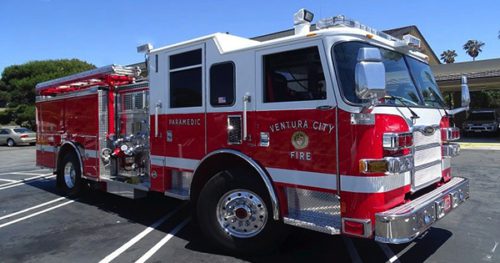 Any change to the Fire Department would likely be unpopular with the public. That makes it a subject considered by Councilmembers, to be too controversial to discuss. The fire department union will become protective of their fellow firefighters and will want to preserve the status quo.
Any change to the Fire Department would likely be unpopular with the public. That makes it a subject considered by Councilmembers, to be too controversial to discuss. The fire department union will become protective of their fellow firefighters and will want to preserve the status quo.
As they have in the past, the unions will apply pressure to the Council. Since four of the seven elected Councilmembers received campaign contributions from Ventura Fire in their last election, the politicians will likely concede as they have in the past. Ventura Fire Department needs reorganizing. Now is the ideal time to do it.
Editor’s Comments
The community will not support another tax rate increase. Pension costs already absorbed the entire $10.8 million raised by Measure. Still, citizens ask why the city doesn’t repair their streets and sidewalks. We can’t hope for an economic miracle to increase revenue, so the city must take steps to curb expenses. Ventura must:
- Lower expenses by not filling all open positions at City Hall. Add those costs back into the budget
- Design and target new commercial businesses to locate in Ventura
- Offer incentives and fee reductions to bring more jobs to Ventura
- Streamline the City Hall process and operations to reduce staff time. It will accelerate the processing time for building and licenses
- Streamline medical response procedures within Ventura Fire. Find ways to reduce fire department costs for those calls. Dispatching a private ambulance and fire trucks with paramedics every time is expensive
- Hold in-depth discussions at the City Council to expand budgeting to a 3-year basis, not one year at a time
INSIST THE CITY COUNCIL MODERNIZES THE BUDGET PROCESS
Below you’ll find the photos of our current City Council. Click on any Councilmember’s photo and you’ll open your email program ready to write directly to that Councilmember.
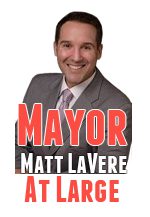 |
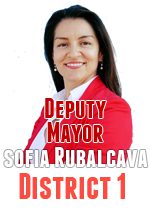 |
|
 |
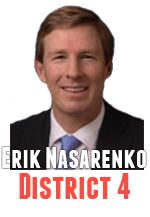 |
|
 |
 |
|
 |
For more information like this, subscribe to our newsletter, Res Publica. Click here to enter your name and email address.





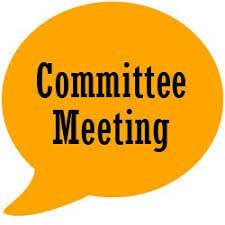 The Council has proposed some significant changes. They include:
The Council has proposed some significant changes. They include: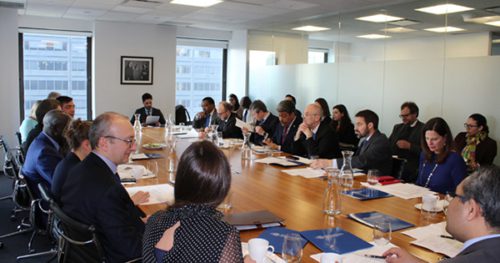 Every Planning Commissioner would be accountable to the Councilmember who appointed him or her.
Every Planning Commissioner would be accountable to the Councilmember who appointed him or her. The proposed changes don’t please everyone. The immediate resistance came from some existing committee members and commissioners. There are two main objections. Some complained about the process. Others believe there will be less transparency and citizen involvement.
The proposed changes don’t please everyone. The immediate resistance came from some existing committee members and commissioners. There are two main objections. Some complained about the process. Others believe there will be less transparency and citizen involvement.


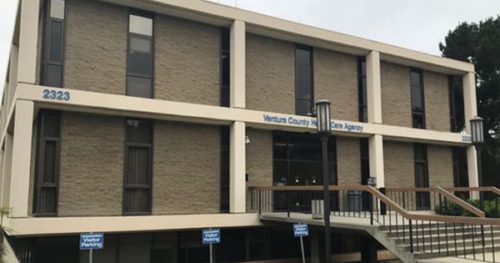 Topping the mayor’s list of priorities was opening a permanent, full-service homeless shelter by December 31, 2019. The date gives this goal specificity. Opening the center doesn’t begin to solve the problem, though. Mayor LaVere and the City Council equate opening a homeless center with improving Ventura’s homeless situation. They are not the same thing.
Topping the mayor’s list of priorities was opening a permanent, full-service homeless shelter by December 31, 2019. The date gives this goal specificity. Opening the center doesn’t begin to solve the problem, though. Mayor LaVere and the City Council equate opening a homeless center with improving Ventura’s homeless situation. They are not the same thing. What’s more, the City Council conflates opening the center with helping the homeless. The goal shouldn’t be to have beds available. That’s an intermediary step. The goal should be to get the homeless off the street and return them to a healthy way of life.
What’s more, the City Council conflates opening the center with helping the homeless. The goal shouldn’t be to have beds available. That’s an intermediary step. The goal should be to get the homeless off the street and return them to a healthy way of life.
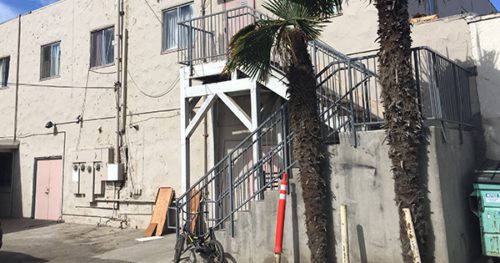 Mayor LaVere’s fourth goal is to beautify the community. He wants to end what he termed “blight.”
Mayor LaVere’s fourth goal is to beautify the community. He wants to end what he termed “blight.”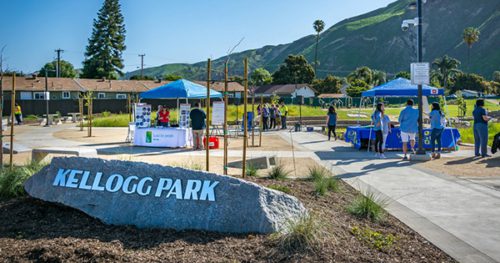 The mayor hopes to achieve this goal by building community parks. The Westside Community Park set the model. Mayor LaVere’s first target is Mission Park.
The mayor hopes to achieve this goal by building community parks. The Westside Community Park set the model. Mayor LaVere’s first target is Mission Park.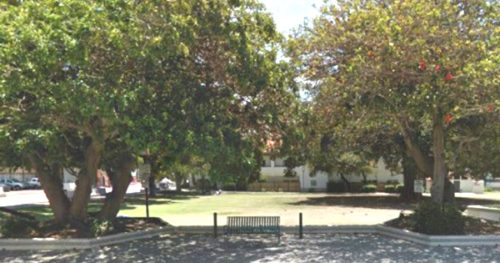 Mission Park is home to a growing number of Ventura’s homeless population. To prepare the area, the homeless must move elsewhere. The 55-bed homeless shelter isn’t the solution. Also, even if we scatter the homeless, there are safety issues. Someone would have to clean the discarded needles, drug paraphernalia and human waste from the park.
Mission Park is home to a growing number of Ventura’s homeless population. To prepare the area, the homeless must move elsewhere. The 55-bed homeless shelter isn’t the solution. Also, even if we scatter the homeless, there are safety issues. Someone would have to clean the discarded needles, drug paraphernalia and human waste from the park.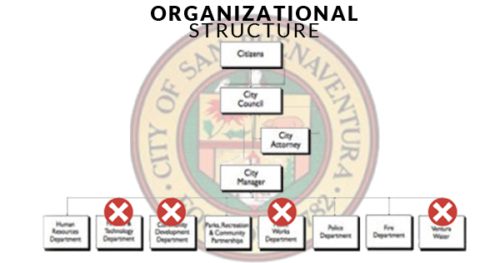 The need for key personnel is a huge problem. To fulfill any of our mayor’s goals requires adequate staff. The final 2019-2020 goal is to stabilize and strengthen our city government. The city has eight unfilled, critical managerial positions and dozens of vacant jobs. The city will achieve none of the other ambitious goals if there aren’t enough workers at City Hall.
The need for key personnel is a huge problem. To fulfill any of our mayor’s goals requires adequate staff. The final 2019-2020 goal is to stabilize and strengthen our city government. The city has eight unfilled, critical managerial positions and dozens of vacant jobs. The city will achieve none of the other ambitious goals if there aren’t enough workers at City Hall.
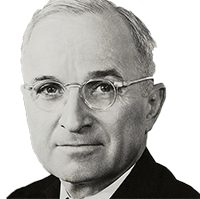


 Costing over $500,000,000 is not the only issue. The more significant issue is that the City Council assumed DPR water was safe to drink.
Costing over $500,000,000 is not the only issue. The more significant issue is that the City Council assumed DPR water was safe to drink.  However, the Consent Decree says the court can extend the time limit in the event of construction constraints, financing problems, or an emergency. It requires Ventura to petition the court requesting an extension, or an agreement with the plaintiff and their lawyers. That has not happened.
However, the Consent Decree says the court can extend the time limit in the event of construction constraints, financing problems, or an emergency. It requires Ventura to petition the court requesting an extension, or an agreement with the plaintiff and their lawyers. That has not happened. On February 4, 2019, Council Member Jim Friedman asked our City Attorney, Gregory Diaz about extending the deadline.
On February 4, 2019, Council Member Jim Friedman asked our City Attorney, Gregory Diaz about extending the deadline.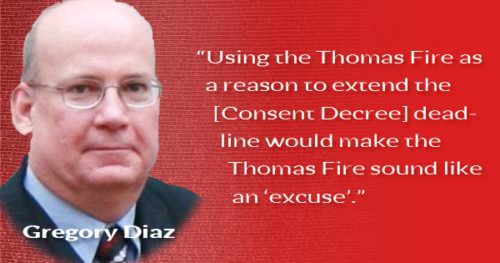




 Ventura Water forces the City Council to get their information from the General Manager. Thus bypassing the entire reason the city established the Water Commission.
Ventura Water forces the City Council to get their information from the General Manager. Thus bypassing the entire reason the city established the Water Commission. You may not have heard about the incident. It’s not because Ventura Water didn’t announce it. They did. Ventura Water fulfilled the letter of the law, but it may have missed the intent behind it. Meeting the legal requirement seems to be the minimum standard. Yet setting the bar at the lowest level may place everyone’s health at risk in the future.
You may not have heard about the incident. It’s not because Ventura Water didn’t announce it. They did. Ventura Water fulfilled the letter of the law, but it may have missed the intent behind it. Meeting the legal requirement seems to be the minimum standard. Yet setting the bar at the lowest level may place everyone’s health at risk in the future. In July, Ventura Water withheld information from the Water Commission. A panel of experts examined
In July, Ventura Water withheld information from the Water Commission. A panel of experts examined 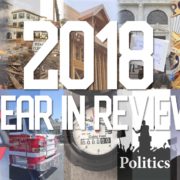


 The City Council waffles on second-story height restrictions for
The City Council waffles on second-story height restrictions for 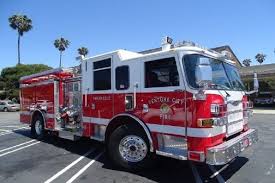 The City Council instructs Ventura Water to focus on connecting to State Water
The City Council instructs Ventura Water to focus on connecting to State Water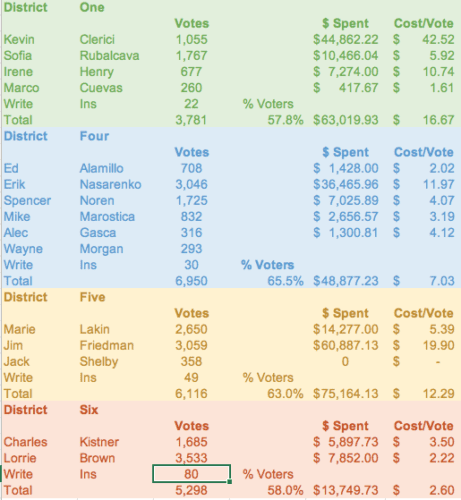
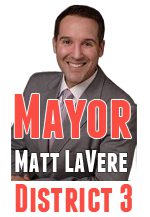



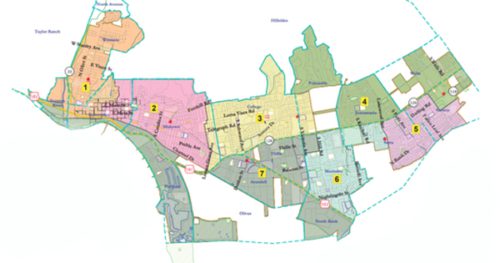

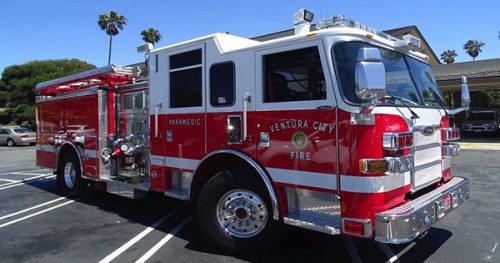
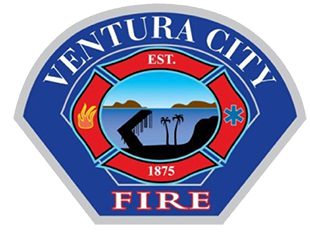


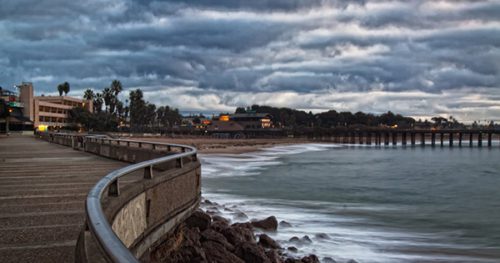

 to the security camera monitoring. The changes include:
to the security camera monitoring. The changes include:
